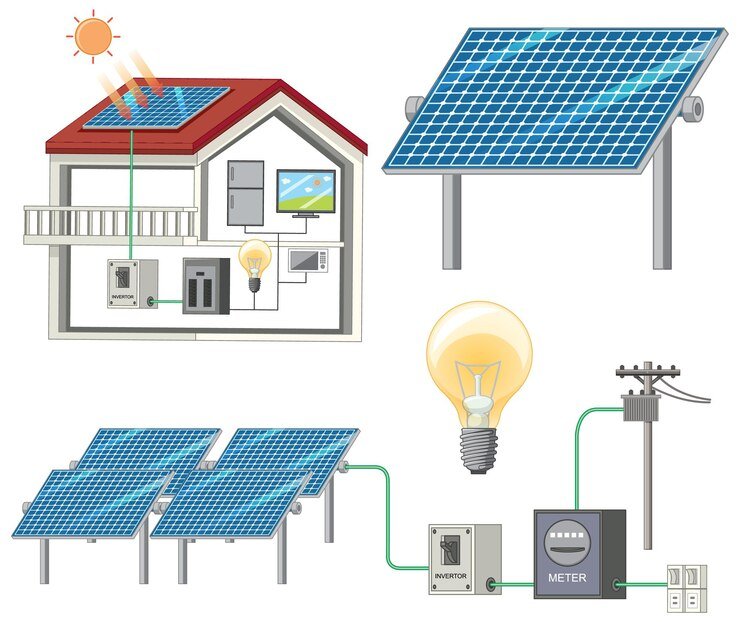
How is Solar Energy Converted into Electricity?
Solar energy is a dominant and renewable source of energy that has been gaining huge acceptance due to its eco-friendly and financial benefits. But how does sunlight convert into electricity? Understanding this process will help businesses and landowners to know the technique behind solar energy systems, which are converting the energy scene across Pakistan.
Solar Panels Capture Sunlight
The procedure of converting sunlight into electricity begins with solar panels. These panels of solar system are made up of photovoltaic cells and characteristically composed with a semiconductor material called silicon. In a day when sun light strikes the external surface of a solar panel then the light particles come from the sun which are photons hit electrons and loose from atoms within the silicon cells.
Solar panels are constructed with two layers of silicon: a positively charged layer and a negatively charged layer. This mixture generates an electric field, which lead to lose the electrons to move, generating a flow of electric current. This is called the photovoltaic effect.
Direct Current (DC) Is Generated
The movement of electrons in the solar panel produces direct current (DC) electricity. In this form, the electricity flows in one direction and is suitable for small devices like batteries. Although, many homes and businesses use alternating current (AC), so additional conversion is needed to make the solar power usable for regular electricity consumption.
The Inverter Converts DC to AC
The inverter is an important part of any solar power system. The inverter changes the direct current produced by the sun into alternating current (AC), which is the typical electricity used for homes, businesses, and industries. These inverters can also test the solar power system for efficiency and will alert any problems on-the-fly, maximizing energy output.
Electricity Is Distributed for Use
When this has been done, the direct current electricity can then be changed into more useful and powerful alternating current and from there sent to your electrical panel (breaker box). Now you can use the electricity from those solar panels to run your sockets, lights etc. Excess energy can then be stored in batteries, or pushed back to the grid depending on the system solution that you implemented.

Net Metering and Energy Storage
In case, solar system connected to national grid, then you will use net metering, which allows home owners to sell their excessive electricity back to the grid for getting discount of monthly electric bill. This means that you can draw electricity at night or on a cloudy day, or anytime there is not enough sunlight. Or you can use the excess electricity your solar panels generate to charge a home battery. It provides a perennial source of electricity, increases energy independence.
Key Components in Solar Power Conversion:
- Solar Panels: Capture sunlight and initiate the photovoltaic effect.
- Inverter: Converts DC into usable AC power.
- Electrical Panel (Breaker Box): Distributes electricity to the home or business.
- Batteries (Optional): Store excess electricity for later use.
- Net Metering (Optional): Allows excess energy to be fed back to the grid.
Why Solar Energy Is a Game-Changer for Pakistan
The most valuable form of energy is solar energy in a sun-rich country like Pakistan. Solar energy solutions can largely indigenize businesses and homeowners from the use of fossil fuels. Not to mention, solar panels save money for a long time Government policies like net metering and reduction in policy rate have made becoming a solar investor quite affordable.
With the global awareness level of environmental sustainability rising, commercial, residential and industrial setups in Pakistan stand to use solar energy as an excellent option towards reducing carbon footprint while minimizing energy costs.
Conclusion
The process of converting solar energy into electricity is an excellent example of modern and innovative technology. From the starting capture of sunlight by photovoltaic cells to the conversion and distribution of clean electricity, each step plays a crucial role in bringing renewable energy. With its numerous advantages, solar power is becoming an essential part of Pakistan’s energy future, empowering businesses and homeowners to harness the power of the sun.
DSG Energy is at the forefront of this transformation, offering turnkey solar solutions tailored to meet the energy needs of Pakistan. By investing in solar energy through DSG Energy, you are not only choosing cost-efficient power but also contributing to a greener, more sustainable planet. Join the renewable energy revolution today with DSG Energy and secure a brighter, cleaner future for generations to come.
By investing in solar energy, you are not just choosing cost-efficient power but also contributing to a greener, more sustainable planet.
“Solar power is the last energy resource that isn’t owned—nobody taxes the sun yet.”

